The key objectives of this project are to understand the formation and growth mechanisms of unsaturated hydrocarbon molecules together with their hydrogen deficient precursors from the bottom up in low temperature environments and to apply these findings to better comprehend the hydrocarbon chemistry in the atmosphere of Saturns moon Titan. This presents a major unsolved chemical problem that will yield to a focused attack given the timely combination of emerging laboratory techniques and theory herein proposed. The implications to the hydrocarbon chemistry of Titan's atmosphere offer extraordinary opportunities for understanding the origin and chemical evolution of the Solar System. First, it provides the potential to reconstruct the scene of the primordial terrestrial atmosphere since Titan and proto-Earth are believed to have emerged with similar atmospheres from the Solar Nebula. Secondly, our studies assist to better understand the origin and formation of the organic, hydrocarbon-based haze layers on Titan. The hydrocarbon molecules present in these atmospheric layers absorb the destructive ultraviolet radiation from the Sun and act as prebiotic ozone to preserve astrobiologically important molecules on Titan. Hence, due to the low surface temperature of 94 K, Titan provides us with a unique prebiotic atmospheric laboratory yielding vital clues at a frozen stage on the chemical composition of the atmosphere of proto-Earth a few billions of years ago.
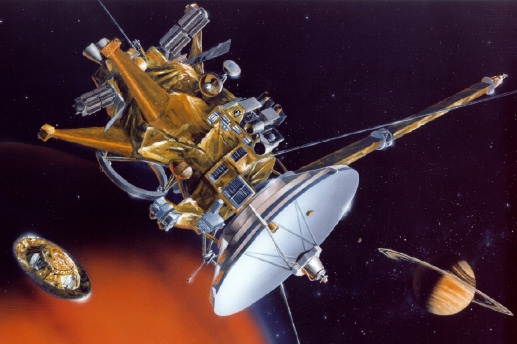
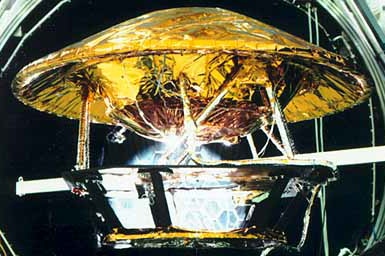
To achieve these objectives, we will develop a tightly integrated collaborative network spanning the full range from fundamental studies in electronic structure theory, photochemistry, reaction dynamics, and kinetics to applications in planetary chemistry. First, utilizing a recently commissioned crossed beams machine, Ralf I. Kaiser (University of Hawaii at Manoa) will investigate the collision energy dependent dynamics of reactions leading to hydrocarbon growth under single collision conditions. These studies, focusing on ethynyl radical reactions with unsaturated hydrocarbons, provide information on the reaction product(s), their branching ratios, and the intermediates involved over a broad range of collision energies from 0.5 kJmol-1 to 40 kJmol-1. The results also yield insight into elementary mechanisms of the reactions of ethynyl radicals with unsaturated hydrocarbons. This reaction class is strongly believed to be the key step in the formation and growth of hydrocarbon molecules in Titans atmosphere. Secondly, since the hydrocarbon rich atmospheres of planets and moons are subjected to solar ultraviolet photons, photodissociation of unsaturated hydrocarbons drives the chemistry as well. Arthur G. Suits (Wayne State University) will characterize wavelength-dependent photodissociation dynamics of a variety of hydrocarbons (121 to 308 nm) exploiting the power of slice ion imaging and the recently developed reflectron multimass imaging approach. These experiments yield wavelength-dependent photodissociation products and their branching fractions under collisionless conditions.
Thirdly, the experiments are complemented by kinetics studies (Ian R Sims, University of Rennes, France) Here, a detailed knowledge on the reaction rate constants of ethynyl radical reactions at the low temperature regime from 10 to 250 K is crucial. These data are complementary to the crossed beams experiments and reveal rate constants of bimolecular reactions of ethynyl radicals. Fourthly, electronic structure calculations (Alexander M. Mebel, Florida International University) are imperative to extend the experiments, which can be carried out only at a limited number of collision energies (crossed beams), wavelengths (photodissociation dynamics), and pressures (crossed beams, photodissociation, kinetics). These calculations deliver absolute rate constants, photodissociation cross sections, branching ratios, and information on the reaction intermediates and products and their pressure-dependence over a broad range from single collision conditions up to three-body collision regimes prevailing in atmospheres of planets and their moons. In those systems where non-statistical effects are observed, we share the chemically accurate potential energy surfaces with collaborator Joel Bowman (Emory University) to carry out dynamics calculations. Finally, we incorporate our findings into reaction networks simulating the chemical evolution of Titan's hydrocarbon chemistry in collaboration with Yuk Yung (Caltech). By comparing the model predictions with publicly available data from the Cassini-Huygens mission to Titan and with astronomical observations (Alan Tokunaga, University of Hawaii at Manoa) the models can then be refined until an agreement between predicted and observed concentrations of hydrocarbon molecules in Titans atmosphere is reached and a coherent picture of the underlying chemistry emerges. We can apply these findings also to the atmospheres of the giant planets in the outer Solar System.
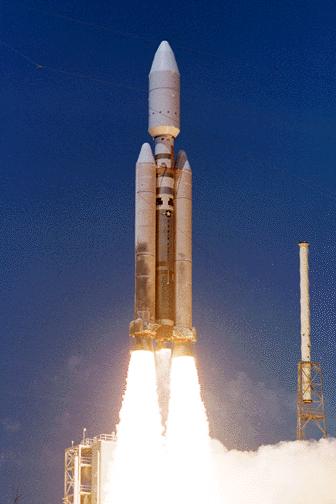
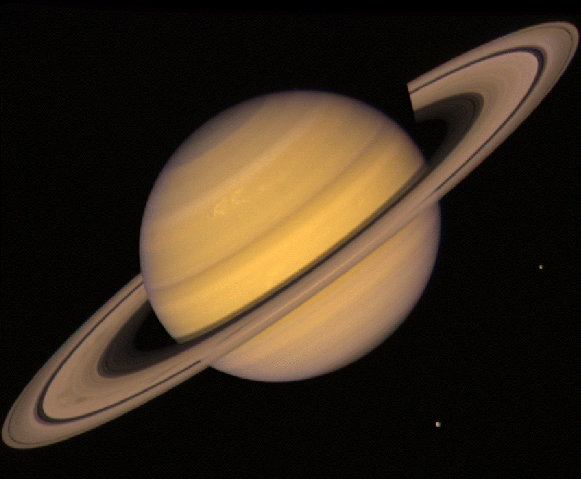
We will develop the following collaborative actions integrating our studies in educational and training activities: i) bringing teaching innovation to the departments of the research teams and preparing novel teaching material, ii) organizing annual scientific workshops in Reaction Dynamics & Astrochemistry, iii) encouraging researchers, graduate and undergraduate students to do hands-on research in chemical reaction dynamics, theoretical chemistry, and astrochemistry, iv) broadening the participation of underrepresented minorities in research and educational activities at the participating institutions, and v) expanding public awareness and relaying the latest breakthroughs from our network to pupils and teachers to enable educators to incorporate research into school and college teaching and also to the public. These studies promise a broad payoff both scientifically and from a perspective of human resources development.
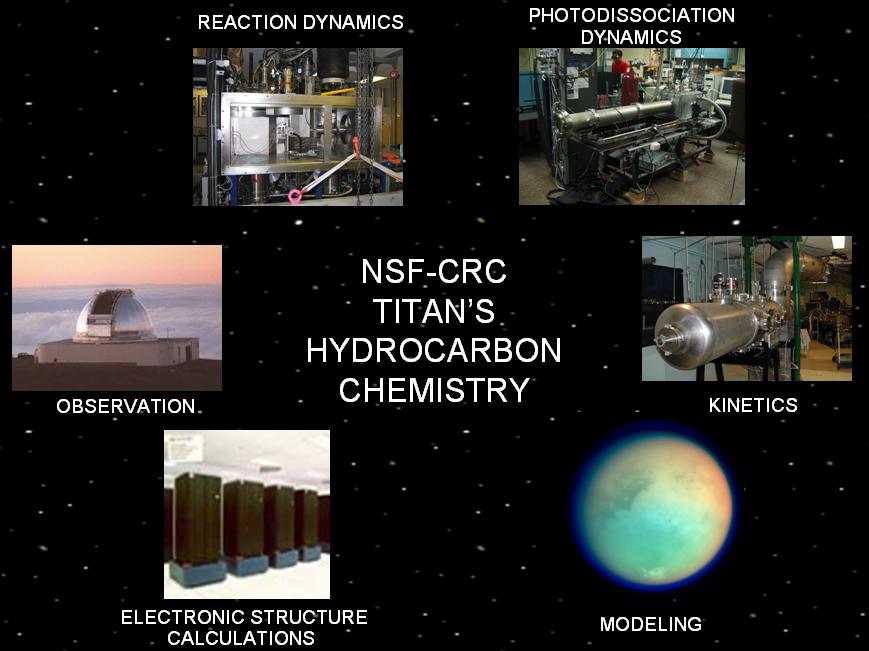
Research Teams
| Name | University | Research Area |
|---|---|---|
| Ralf I. Kaiser (Senior Investigator) | University of Hawaii at Manoa | Reaction Dynamics |
| Alexander M. Mebel (Senior Investigator) | Florida International University | Electronic Structure Calculations |
| Arthur G. Suits (Senior Investigator) | University of Missouri | Photodissociation Dynamics |
| Ian R. Sims (Senior Investigator) | University of Rennes, France | Kinetic Studies |
| Joel Bowman (Collaborator) | Emory University | Dynamic Calculations |
| Alan Tokunaga (Collaborator) | University of Hawaii at Manoa | Observations |
| Yuk Yung (Collaborator) | California Institute of Technology | Modeling |
Recent Selected Publications
1. L.C.L. Huang, Y.T. Lee, R.I. Kaiser, Crossed beam reaction of the cyanogen radical, CN(X2Σ+), with acetylene, C2H2(X1Σg+): Observation of cyanoacetylene, HCCCN(X1Σ+), J. Chem. Phys. 110, 7119-7122 (1999). (PDF)
2. L.C.L. Huang, N. Balucani, Y.T. Lee, R.I. Kaiser, Y. Osamura, Crossed beam reaction of the cyano radical, CN(X2Σ+), with methylacetylene, CH3CCH (X1A1): Observation of cyanopropyne, CH3CCCN (X1A1), and cyanoallene, H2CCCHCN (X1A'), J. Chem. Phys. 111, 2857-2860 (1999). (PDF)
3. N. Balucani, O. Asvany, A.H.H. Chang, S.H. Lin, Y.T. Lee, R.I. Kaiser, H.F. Bettinger, P.v.R. Schleyer, H.F. Schaefer III, Crossed beam reaction of cyano radicals with hydrocarbon molecules. I. Chemical dynamics of cyanobenzene (C6H5CN; X1A1) and perdeutero cyanobenzene (C6D5CN; X1A1) formation from reaction of CN(X2Σ+) with benzene, C6H6(X1A1g), and d6-benzene, C6D6(X1A1g), J. Chem. Phys. 111, 7457-7471 (1999). (PDF)
4. N. Balucani, O. Asvany, A.H.H. Chang, S.H. Lin, Y.T. Lee, R.I. Kaiser, H.F. Bettinger, P.v.R. Schleyer, H.F. Schaefer III, Crossed beam reaction of cyano radicals with hydrocarbon molecules. II. Chemical dynamics of 1-cyano-1-methylallene (CNCH3CCCH2; X1A') formation from reaction of CN(X2Σ+) with dimethylacetylene, CH3CCCH3 (X1A1'), J. Chem. Phys. 111, 7472-7479 (1999). (PDF)
5. R.I. Kaiser, J.W. Ting, L.C.L. Huang, N. Balucani, O. Asvany, Y.T. Lee, H. Chan, D. Stranges, D. Gee, A versatile source to produce high-intensity, pulsed supersonic radical beam for crossed-beams experiments: the cyanogen radical CN(X2Σ+) as a case study, Rev. Sci. Instrum. 70, 4185-4191 (1999). (PDF)
6. N. Balucani, O. Asvany, Y. Osamura, L.C.L. Huang, Y.T. Lee, R.I. Kaiser, Laboratory investigation on the formation of unsaturated nitriles in Titan's atmosphere, Planetary and Space Science 48, 447-462 (2000). (PDF)
7. N. Balucani, O. Asvany, A.H.H. Chang, S.H. Lin, Y.T. Lee, R.I. Kaiser, Y. Osamura, Crossed beam reaction of cyano radicals with hydrocarbon molecules. III. Chemical dynamics of vinylcyanide (C2H3CN;X1A') formation from reaction of CN(X2Σ+) with ethylene, C2H4(X1Ag), J. Chem. Phys 113, 8643-8655 (2000). (PDF)
8. L.C.L. Huang, O. Asvany, A.H.H. Chang, N. Balucani, S.H. Lin, Y.T. Lee, R.I. Kaiser, Y. Osamura, Crossed beam reaction of cyano radicals with hydrocarbon molecules. IV. Chemical dynamics of cyanoacetylene (HCCCN; X1Σ+) formation from reaction of CN(X2Σ+) with acetylene, C2H2(X1Σg+), J. Chem. Phys. 113, 8656-8666 (2000). (PDF)
9. N. Balucani, O. Asvany, L.C.L. Huang, Y. T. Lee, R.I. Kaiser, Y. Osamura, H.F. Bettinger, Formation of Nitriles in the Interstellar Medium via reactions of cyano radicals, CN(X2Σ+), with unsaturated hydrocarbons, Ap.J. 545, 892-906 (2000). (PDF)
10. R.I. Kaiser, C.C. Chiong, O. Asvany, Y.T. Lee, F. Stahl, P.v.R. Schleyer, H.F. Schaefer III, Chemical dynamics of d1-methyldiacetylene (CH3CCCCD; X1A1) and d1-ethynylallene (H2CCCH(C2D); X1A') formation from reaction of C2D(X2Σ+) with methylacetylene CH3CCH(X1A1), J. Chem. Phys. 114, 3488-3496 (2001). (PDF)
11. F. Stahl, P.v.R. Schleyer, H.F. Bettinger, R.I. Kaiser, Y.T. Lee, H.F. Schaefer III, Reaction of the ethynyl radical, C2H, with methylacetylene, CH3CCH, under single collision conditions: implications for astrochemistry, J. Chem. Phys. 114, 3476-3487 (2001). (PDF)
12. R.I. Kaiser, N. Balucani, The Formation of Nitriles in Hydrocarbon-Rich Atmospheres of Planets and Their satellites: Laboratory Investigations by the Crossed Molecular Beam Technique, Acc. Chem. Res., 34, 699-706 (2001). (PDF)
13. R.I. Kaiser, The role of cyano (CN) and Ethynyl (C2H) Radicals in astrobiology and implications to the origin of life on Earth, ESA -Special Publication 'Exo- and Astrobiology', 496, 145-153 (2001). (PDF)
14. R.I. Kaiser, N. Balucani, Astrobiology - The final frontier in chemical reaction dynamics, Int. J. Astrobiology 1, 15-23 (2002). (PDF)
15. R.I. Kaiser, F. Stahl, P.v.R. Schleyer, H.F. Schaefer III, Atomic and molecular hydrogen elimination in the crossed beam reaction of d1-ethinyl radicals C2D(X2Σ+) with acetylene,C2H2(X1 Σg+): Dynamics of d1-diacetylene (HCCCCD) and d1-butadiynyl (DCCCC) formation, PCCP, 4, 2950-2958 (2002). (PDF)
16. F. Stahl, P.v.R. Schleyer, H.F. Schaefer III, R.I. Kaiser, Reactions of ethynyl radicals as a source of C4 and C5 hydrocarbons in Titan's atmosphere, Planetary and Space Science 50, 685-692 (2002). (PDF)
17. N. Balucani, R.I. Kaiser, Cyanoalkynes and Cyanopolyynes: from Crossed Beam Experiments to Astrochemistry, Polyynes: Synthesis, Properties, and Applications, F. Cataldo, ed., CRS Press, New York, 285-322 (2005).
18. Y. Chin, R.I. Kaiser, C. Lemme, C. Henkel, Detection of Interstellar Cyanoallene and its implications for Astrochemistry in: Astrochemistry - From Laboratory Studies to Observations, American Institute of Physics, 855, 149-153 (2006).
19. A. Landera, S.P. Krishtal, V.V. Kislov, A.M. Mebel, R.I. Kaiser, Theoretical Study of the C6H3 Potential Energy Surface and Rate Constants and Product Branching Ratios of the C2H(2Σ+) + C4H2(1Σg+) and C4H(2Σ+) + C2H2(1Σ+) Reactions, J. Chem. Phys. 128, 214301/1-12 (2008). (PDF)
20. A. Landera, A.M. Mebel, R.I. Kaiser, Theoretical Study of the Reaction Mechanism of Ethynyl Radical with Benzene and Related Reactions on the C8H7 Potential Energy Surface, CPL 459, 54-59 (2008). (PDF)
21. X. Gu, F. Zhang, R.I. Kaiser, Reaction Dynamics on the Formation of 1- and 3-Cyanopropylene in the Crossed Beams Reaction of Ground State Cyano Radicals (CN) with Propylene (C3H6) and Its Deuterated Isotopologues, JPCA 112, 9607-9613 (2008). (PDF)
22. Y.S. Kim, R.I. Kaiser, An Infrared Spectroscopic Study of Amorphous and Crystalline Ices of Vinylacetylene and Implications for Saturn's Satellite Titan, Ap.J. SS 181, 543-547 (2009). (PDF)
23. L. Zhou, R.I. Kaiser, A.T. Tokunaga, Infrared Spectroscopy of Crystalline and Amorphous Diacetylene (C4H2) and Implications to Titan's Atmospheric Conditon, Planet. Space Sciences 57, 830-835 (2009). (PDF)
24. F. Zhang, S. Kim, R.I. Kaiser, A Crossed Molecular Beams Study of the Reaction of the Ethynyl Radical (C2H(X2Σ+) with Allene (H2CCCH2(X1A1)), PCCP 11, 4707-4714 (2009). (PDF)
25. F. Zhang, S. Kim, R.I. Kaiser, A.M. Mebel, A Crossed Beams and Ab Initio Investigation on the Formation of Cyanodiacetylene in the Reaction of Cyano Radicals with Diacetylene, J. Chem. Phys. 130 234308 (2009). (PDF)
26. X. Gu, R.I. Kaiser, A.M. Mebel, V.V. Kislov, S.J. Klippenstein, L.B. Harding, M.C. Liang, Y.L. Yung, A Crossed Molecular Beams Study on the Formation of the Exotic Cyanoethynyl Radical in Titan's Atmosphere, Ap. J. 701 1797-1803 (2009). (PDF)
27. X. Gu, Y.S. Kim, R.I. Kaiser, A.M. Mebel, M.C. Liang, Y.L. Yung, Chemical Dynamics of Triacetylene Formation and Implications to the synthesis of polyynes in Titan's Atmosphere, Proceedings National Academy of Sciences 106, 16078-16083 (2009). (PDF)
28. W. Zheng, D.C. Jewitt, R.I. Kaiser, On the State of Water Ice on Saturn's Moon Titan and Implications to Icy Bodies in the Outer Solar System, JPCA (Special Issue) 113, 11174-11181 (2009). (PDF)
29. F. Zhang, S. Kim, R.I. Kaiser, S.P. Krishtal, A.M. Mebel, Crossed Molecular Beams Study on the Formation of Vinylacetylene in Titan's Atmosphere, JPCA (Special Issue) 113, 11167-11173 (2009). (PDF)
30. S. Krishtal, A.M. Mebel, R.I. Kaiser, A Theoretical Study of the Reaction Mechanism and Product Branching Ratios of C2H + C2H4 and Related Reactions on the C4H5 Potential Energy Surface, JPCA (Special Issue) 113, 11112-11128 (2009). (PDF)
31. C.H. Huang, R.I. Kaiser, A.H.H. Chang, Theoretical Study on the Reaction of Ground State Cyano Radical with Propylene in Titan's Atmosphere, JPCA 113, 12675-12685 (2009). (PDF)
32. Y.S. Kim, C.J. Bennett, L. Sheng, O'Brian, R.I. Kaiser, Laboratory Study on the Irradiation of Solid Ethane Analog Ices and Implications to Titan's Chemistry, Ap. J. 711, 744-756 (2010). (PDF)
33. B. Jones, F. Zhang, P. Maksyutenko, A.M. Mebel, R.I. Kaiser, Crossed Molecular Beam Study on the Formation of Phenylacetylene and Its Relevance to Titan's Atmosphere, JPCA 114, 5256-5262 (2010). (PDF)
34. C. Huang, F. Zhang, R.I. Kaiser, V.V. Kislov, A.M. Mebel, R. Silva, W.K. Gichuhi, A.G. Suits, Photodissociation of the Diacetylene Dimer and Implications for Hydrocarbon Growth in Titan's Atmosphere, Ap. J. 714, 1249-1255 (2010). (PDF)
35. O. Kostko, J. Zhou, B-J Sun, J.S. Lie, A.H.H. Chang, R.I. Kaiser, M. Ahmed, Determination of Ionization Energies of CnN (n = 4 - 12): Vacuum Ultraviolet Photoionization Experiments and Theoretical Calculations, Ap. J. 717, 674-682 (2010). (PDF)
36. L. Zhou, W. Zheng, R.I. Kaiser, A. Landera, A.M. Mebel, M.C. Liang, Cosmic-Ray-Mediated Formation of Benzene on the Surface of Saturn's Moon Titan, Ap. J. 718, 1243-1251 (2010). (PDF)
37. C.J. Bennett, S.B. Morales, S.D. Le Picard, A. Canosa, I.R. Sims, Y.H. Shih, A.H.H. Chang, X. Gu, F. Zhang, R.I. Kaiser, A chemical dynamics, kinetics, and theoretical study on the reaction of the cyano radical (CN; X2Σ+) with phenylacetylene (C6H5CCH; X1A1), PCCP 12, 8737-8749 (2010). (PDF)
38. A.D. Estillore, L.M. Visger, R.I. Kaiser, A.G. Suits, Crossed-Beam Imaging of the H Abstraction Channel in the Reaction of CN with 1-Pentene, JPC Lett. 1, 2417-2421 (2010). (PDF)
39. R.I. Kaiser, B-J Sun, H.M. Lin, A.H.H. Chang, A.M. Mebel, O. Kostko, M. Ahmed, An Experimental and Theoretical Study on the Ionization Energies of Polyynes (H(CC)nH; n = 1-9), Ap. J. 719, 1884-1889 (2010). (PDF)
40. R.I. Kaiser, P. Maksyutenko, C. Ennis, F. Zhang, X. Gu, A.M. Mebel, O. Kostko, M. Ahmed, Untangling the Chemical Evolution of Titan's Atmosphere and Surface - From Homogeneous to Heterogeneous Chemistry, Faraday Discussion 147: Chemistry of the Planets, 429-478 (2010). (PDF)
41. S.B. Morales, C.J. Bennett, S.D. Le Picard, A. Canosa, I.R. Sims, B-J Sun, P.H. Chen, A.H.H. Chang, V.V. Kislov, A.M. Mebel, X. Gu, F. Zhang, P. Maksyutenko, R.I. Kaiser, A Crossed Molecular Beam, Low-Temperature Kinetics, and Theoretical Inverstigation of the Reaction of the Cyano Radical (CN) with 1,3-Butandiene (C4H6). A Route to Complex Nitrogen-Bearing Molecules in Low-Temperature Extraterrestrial Environments, Ap. J., 742, 26-35 (2011). (PDF)
42. R.I. Kaiser, A.M. Mebel, On the Formation of Polyacetylenes and Cyanopolyacetylenes in Titans Atmosphere and their Role in Astrobiology, Chem. Rev. Soc. 41, 5490-5501 (2012). (PDF)
43. D.S.N. Parker, R.I. Kaiser, A.M. Mebel, The role of isovalency in the reactions of the cyano (CN), boron monoxide (BO), silicon nitride (SiN), and ethynyl (C2H) radicals with unsaturated hydrocarbons acetylene (C2H2) and ethylene (C2H4), Chem. Soc. Rev., 43, 2701-2713 (2014). (PDF)
44. B.J. Sun, C.H. Huang, S.Y. Chen, S.H. Chen, R.I. Kaiser, A.H.H. Chang, Theoretical Study on Reaction Mechanism of Ground-State Cyano Radical with 1,3-Butadiene: Prospect of Pyridine Formation, J. Phys. Chem. A, 118, 7715-7724 (2014). (PDF)



